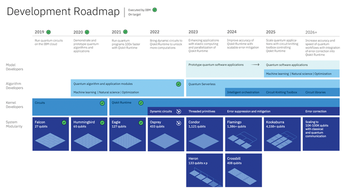Qiskit – Practical open source framework for quantum computing
Smart Toolbox

Qiskit is an open source framework that aims to make quantum computing technology both understandable and ready for production.
IBM is working on increasing the performance of the interaction between hardware and software. The milestones [1] planned for this effort are shown in the IBM Quantum Development Roadmap (Figure 1). To benefit from IBM Quantum hardware, the software and infrastructure must support a wide range of requirements and experiences. This need for versatility requires tools for different types of developers.
 Figure 1: IBM has laid out exactly what goals it wants to achieve, and when, in the IBM Quantum Development Roadmap.
Figure 1: IBM has laid out exactly what goals it wants to achieve, and when, in the IBM Quantum Development Roadmap.
Qiskit (think "kiss kit") is a freely available software development kit (SDK) for working with quantum computers at the level of pulses, circuits, or application modules. At least, that's what the SDK home page says. Since its first publication in 2017, the project has grown and undergone some fundamental changes.
[...]
Buy this article as PDF
(incl. VAT)
Buy Linux Magazine
Subscribe to our Linux Newsletters
Find Linux and Open Source Jobs
Subscribe to our ADMIN Newsletters
Support Our Work
Linux Magazine content is made possible with support from readers like you. Please consider contributing when you’ve found an article to be beneficial.

News
-
Debian Unleashes Debian Libre Live
Debian Libre Live keeps your machine free of proprietary software.
-
Valve Announces Pending Release of Steam Machine
Shout it to the heavens: Steam Machine, powered by Linux, is set to arrive in 2026.
-
Happy Birthday, ADMIN Magazine!
ADMIN is celebrating its 15th anniversary with issue #90.
-
Another Linux Malware Discovered
Russian hackers use Hyper-V to hide malware within Linux virtual machines.
-
TUXEDO Computers Announces a New InfinityBook
TUXEDO Computers is at it again with a new InfinityBook that will meet your professional and gaming needs.
-
SUSE Dives into the Agentic AI Pool
SUSE becomes the first open source company to adopt agentic AI with SUSE Enterprise Linux 16.
-
Linux Now Runs Most Windows Games
The latest data shows that nearly 90 percent of Windows games can be played on Linux.
-
Fedora 43 Has Finally Landed
The Fedora Linux developers have announced their latest release, Fedora 43.
-
KDE Unleashes Plasma 6.5
The Plasma 6.5 desktop environment is now available with new features, improvements, and the usual bug fixes.
-
Xubuntu Site Possibly Hacked
It appears that the Xubuntu site was hacked and briefly served up a malicious ZIP file from its download page.

